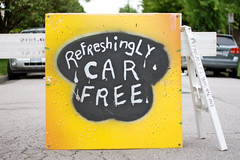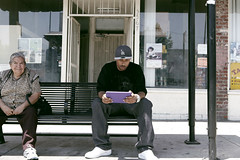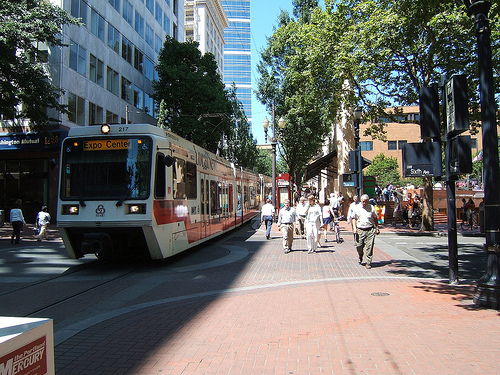Best US cities for living car-free? None of the above, really

Posted November 18, 2011 at 1:49PM
Earlier this week, a story began making the rounds about the ten best metro areas in which to live without a car. The winners include some of the usual suspects: San Francisco, Portland, New York City, Honolulu, Seattle, San Jose (?), Denver, Salt Lake City, Los Angeles, and Boston.
The original article was written on the MSNBC blog 24/7 Wall St. by Charles B. Stockdale. It certainly got some of the basics right about walkability:
“Several factors make a city easy to live in without a car. The most important one is a widely available and efficient public transportation system. Another is having daily amenities, such as groceries, shopping, schools and entertainment, nearby and within easy reach on foot or by bicycling. The best cities have both features and 24/7 Wall St. has identified the ten best ones to live without a car.
“For people without cars, large cities with dense populations can be easier to handle if they have exceptional levels of ‘walkability.’ New York City, for example, is great for a car-free lifestyle because the majority of daily conveniences are reachable on foot. In Boston, the situation is similar. Both cities also have highly efficient public rail systems. As a result, people can easily get to work even if the distance is too far for walking.
“More sprawling metropolitan areas can also be easier to negotiate for those without cars as long as they have highly developed public transit systems . . .”
I don’t disagree with that, and have said as much with some frequency on this blog.
 But the article’s upbeat tone masks what its data sources really show: the vast majority of residents in even these “best” cities are unable to get to work without a car, even if they are heroically committed to using public transit.
But the article’s upbeat tone masks what its data sources really show: the vast majority of residents in even these “best” cities are unable to get to work without a car, even if they are heroically committed to using public transit.
In particular, the evaluation of best cities for car-free living employed five measures: the percentage of neighborhoods covered by public transit; the average frequency of service in those neighborhoods; the share of jobs reachable within 90 minutes or less by public transit; the average Walk Score for the primary city of each metropolitan area; and the percentage of commuters who bicycle to work. The transit measures were taken from an analysis by the Brookings Institution that I discussed a few months ago.
I could quibble with a number of these, but what really stands out for me is that, even in San Francisco, the article’s number one best place to live without a car, fully 65 percent of jobs are not reachable by transit, according to Brookings. In Boston, the tenth best place to live without a car, 70 percent of jobs are not reachable by transit. Wow. This means that these places may be great to live in without a car, but only if you don’t have to get to work. In seven of the ten locations, a majority of jobs are not reachable by transit from most neighborhoods. (Three areas – Salt Lake City, San Jose, and Honolulu – apparently do have a majority of jobs reachable by transit.)
What’s more, if you go inside the Brookings data (in the study’s technical appendix), you learn that the Institution used a very generous approach to determining which neighborhoods had transit access and how far commuters were willing to ride to work. Specifically, a location was determined to have transit service if there was a stop anywhere within three-quarters of a mile.  That's pretty far: most research concludes that, in fact, people will walk only one-quarter mile or less to bus service (people will walk a little farther, up to half a mile, to rail service).
That's pretty far: most research concludes that, in fact, people will walk only one-quarter mile or less to bus service (people will walk a little farther, up to half a mile, to rail service).
And who wants a commute that takes 90 minutes in each direction? Actually, for the places considered transit-reachable by Brookings, the commute could be even longer, given walking time to cover three-quarters of a mile just to get to the stop, and then waiting time. If a three-quarter-mile walk in nice weather takes 12 minutes or so for most people, and there’s also a bit of a walk on the other end of the transit ride to the job, the study is actually measuring the percentage of jobs reachable in 105 minutes or more, each way, plus waiting time. That’s three and one-half hours or longer spent commuting each workday.
The good news, I suppose, is that in these cities and elsewhere there are highly accessible neighborhoods convenient to jobs, amenities and transit. I know plenty of people - generally on the younger side, without a family - who do go car-free here in Washington, in San Francisco, certainly in New York. But, unfortunately, the Brookings data show that they do not represent a large portion of the overall population.
The fact that, in seven of the ten “best” locations for being car-free, most residents in most neighborhoods still cannot get to work on transit (even allowing for three and a half-hours of daily commuting time) tells me that living car-free is actually pretty lousy most everywhere for most people. In this context, “best” still isn't good enough.
Move your cursor over the images for credit information.
